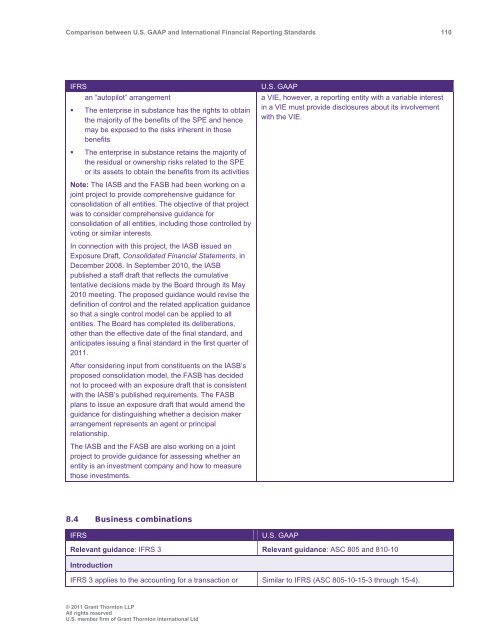Comparison between U.S. GAAP and International ... - Grant Thornton
Comparison between U.S. GAAP and International ... - Grant Thornton
Comparison between U.S. GAAP and International ... - Grant Thornton
You also want an ePaper? Increase the reach of your titles
YUMPU automatically turns print PDFs into web optimized ePapers that Google loves.
<strong>Comparison</strong> <strong>between</strong> U.S. <strong>GAAP</strong> <strong>and</strong> <strong>International</strong> Financial Reporting St<strong>and</strong>ards 110<br />
IFRS<br />
an “autopilot” arrangement<br />
• The enterprise in substance has the rights to obtain<br />
the majority of the benefits of the SPE <strong>and</strong> hence<br />
may be exposed to the risks inherent in those<br />
benefits<br />
• The enterprise in substance retains the majority of<br />
the residual or ownership risks related to the SPE<br />
or its assets to obtain the benefits from its activities<br />
Note: The IASB <strong>and</strong> the FASB had been working on a<br />
joint project to provide comprehensive guidance for<br />
consolidation of all entities. The objective of that project<br />
was to consider comprehensive guidance for<br />
consolidation of all entities, including those controlled by<br />
voting or similar interests.<br />
In connection with this project, the IASB issued an<br />
Exposure Draft, Consolidated Financial Statements, in<br />
December 2008. In September 2010, the IASB<br />
published a staff draft that reflects the cumulative<br />
tentative decisions made by the Board through its May<br />
2010 meeting. The proposed guidance would revise the<br />
definition of control <strong>and</strong> the related application guidance<br />
so that a single control model can be applied to all<br />
entities. The Board has completed its deliberations,<br />
other than the effective date of the final st<strong>and</strong>ard, <strong>and</strong><br />
anticipates issuing a final st<strong>and</strong>ard in the first quarter of<br />
2011.<br />
After considering input from constituents on the IASB’s<br />
proposed consolidation model, the FASB has decided<br />
not to proceed with an exposure draft that is consistent<br />
with the IASB’s published requirements. The FASB<br />
plans to issue an exposure draft that would amend the<br />
guidance for distinguishing whether a decision maker<br />
arrangement represents an agent or principal<br />
relationship.<br />
The IASB <strong>and</strong> the FASB are also working on a joint<br />
project to provide guidance for assessing whether an<br />
entity is an investment company <strong>and</strong> how to measure<br />
those investments.<br />
U.S. <strong>GAAP</strong><br />
a VIE, however, a reporting entity with a variable interest<br />
in a VIE must provide disclosures about its involvement<br />
with the VIE.<br />
8.4 Business combinations<br />
IFRS<br />
U.S. <strong>GAAP</strong><br />
Relevant guidance: IFRS 3 Relevant guidance: ASC 805 <strong>and</strong> 810-10<br />
Introduction<br />
IFRS 3 applies to the accounting for a transaction or Similar to IFRS (ASC 805-10-15-3 through 15-4).<br />
© 2011 <strong>Grant</strong> <strong>Thornton</strong> LLP<br />
All rights reserved<br />
U.S. member firm of <strong>Grant</strong> <strong>Thornton</strong> <strong>International</strong> Ltd
















